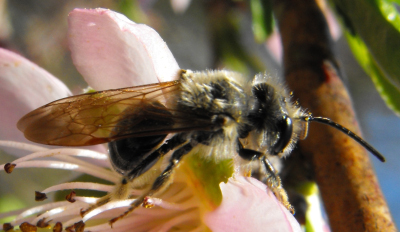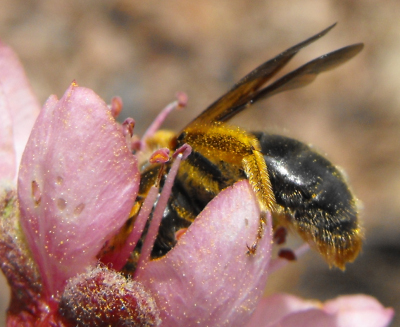
Miner bees: Andrena sp.
 Miner
bees (also called mining or digger bees, in the genus Andrena) seem to be custom made for
fruit tree pollination. The adults are present only during March
and April, right when your trees are blooming, and the bees are seldom
distracted by ground-flowering weeds. (Our honeybees, in
contrast, seem to be spending most of their time on dead nettles at the
moment.) Miner bees are also able to fly at chillier temperatures
than many of the other pollinators I've discussed this week, so they're
active during the morning and evening and on drippy days.
Miner
bees (also called mining or digger bees, in the genus Andrena) seem to be custom made for
fruit tree pollination. The adults are present only during March
and April, right when your trees are blooming, and the bees are seldom
distracted by ground-flowering weeds. (Our honeybees, in
contrast, seem to be spending most of their time on dead nettles at the
moment.) Miner bees are also able to fly at chillier temperatures
than many of the other pollinators I've discussed this week, so they're
active during the morning and evening and on drippy days.
 I
found at least two species of miner bees on
our peach tree, which is to be expected since 1,300 Andrena
species exist worldwide. The
bees are similar in size to a honeybee --- one of my species is a bit
smaller and one a bit larger --- but sparser hair on the bee's body
gives the miner bee
a mean look. Luckily, they're not mean at all, and are even less
likely than a honeybee to sting. You can distinguish miner bees
by their dark-tinted wings and extra-hairy back legs. These
pollen brushes seem to go, as one website put
it, "seemingly in their 'armpits'".
I
found at least two species of miner bees on
our peach tree, which is to be expected since 1,300 Andrena
species exist worldwide. The
bees are similar in size to a honeybee --- one of my species is a bit
smaller and one a bit larger --- but sparser hair on the bee's body
gives the miner bee
a mean look. Luckily, they're not mean at all, and are even less
likely than a honeybee to sting. You can distinguish miner bees
by their dark-tinted wings and extra-hairy back legs. These
pollen brushes seem to go, as one website put
it, "seemingly in their 'armpits'".
Despite being
custom-made for fruit-tree pollination, miner bees aren't
all that common in large-scale orchards. The bees won't fly very
far to forage, so they require a wild nesting site close to the trees
they feed from. To encourage Andrena
in your garden, provide them with some loose soil near or under shrubs,
preferably on a warm, south-facing bank. Your miner bees will dig
a burrow in the soil and lay eggs in brood cells full of pollen and
nectar, just like sweat bees
do. The adults will die in late spring soon after laying their
eggs, and won't be seen again until your peach trees are once again in
bloom.
| This post is part of our Native Pollinators lunchtime series.
Read all of the entries: |
Want more in-depth information? Browse through our books.
Or explore more posts by date or by subject.
About us: Anna Hess and Mark Hamilton spent over a decade living self-sufficiently in the mountains of Virginia before moving north to start over from scratch in the foothills of Ohio. They've experimented with permaculture, no-till gardening, trailersteading, home-based microbusinesses and much more, writing about their adventures in both blogs and books.
Want to be notified when new comments are posted on this page? Click on the RSS button after you add a comment to subscribe to the comment feed, or simply check the box beside "email replies to me" while writing your comment.
